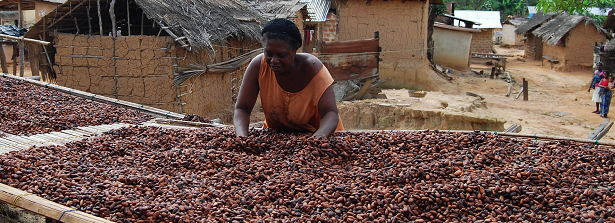Access to finance: Information transparency system cocoa farmers in Ghana

Duration: September 1, 2015 – August 31, 2020
Project information
Aim: The cocoa industry has for years been characterised by high and growing demand and low and declining supply. As a result, prices of cocoa have been increasing, and sustainability of the crop questioned. Many public-private partnerships have addressed productivity issues in the short term. However, long-term sustainability of cocoa farms and attractiveness of the sector to future generations of farmers depends on farmers’ ability to get access to input supplies and other services, for which they need credit. Some of the main reasons why cocoa farmers have no access to credit include no hard collateral, high-perceived risk and transaction costs, high moral hazard (cocoa side selling) and low financial literacy of farmers. The aim of this project is to test how a farmer information system can help farmers get access to finance by reducing transaction costs, moral hazard and risks, at low cost and large scale.
Objective: The project examines whether the introduction of a farmer information platform improves cocoa farmers’ access to finance. The overall objective of this research is to show to what extent farmer information transparency provided by the ICT system can be used to attract financial institutions to lend to cocoa farmers, encouraging information as a reputational collateral and thus, a risk management tool. By closing information asymmetry between financial institutions and farmers, the former is more likely to offer financial services to the latter. Technology is expected to reduce know-your-customer and transaction costs of reaching out to smallholders.
Method: The consortium aims to measure the causal impact of the information system by using both quantitative and qualitative impact evaluation techniques. The qualitative analysis is necessary to provide key insights on details of how the information system influences the different stakeholders, especially cocoa farmers, but also purchasing clerks, and financial intermediaries. Moreover, the qualitative analysis can help to obtain information about variables that are difficult to quantify. The research group also uses conduct in-depth interviews with financial intermediaries to get more detailed information about how they value information systems in relation to credit supply and credit terms. After having measured impact of the information system, the project group aims to conduct cost-effectiveness analysis e.g. by using benchmark secondary data collected during the baseline.
Country: Ghana.
Dutch policy goals: Inclusive business models for food security; and Regional trade for food security.
Progress reports
Year 1: The main objective of the 1st year of the project was to conduct a baseline survey of cocoa farmers, which has been accomplished successfully. We have interviewed 1500 farmers of one cocoa cooperative dispersed over 22 communities in the Eastern Region of Ghana. The survey conducted covered a number of socio-economic topics, including household information, economic activities of various household members, their sources of income, expenditures, savings, existing loans, financial literacy, social networks etc. This will allow us to observe the socio-economic impact of the information intervention(s) in 3 years from now.
Summary mid-term review: The project aims to investigate how to increase farmer inclusion through information transparency; in other words, how information about farmers and their farming practices can help them get access to credit. There is two ends to this coin – one is looking what farmers can do to help themselves; and the other is what financial institutions/ value chain players can do to facilitate access to credit.
On the farmer side, farmers can improve the likelihood of getting access to credit by building savings first. Knowing that farmers have savings is a form of collateral that banks in Ghana assess when considering giving out loans. We have successfully completed 2 studies to look into how to encourage farmers to save.
On the value chain side, we are studying how to improve automation of information collection to ensure transparency that will allow farmers to get access to credit as well as facilitate trade. An aspect of that information transparency is using farmer certification data for credit.
Year 3: The project aims to investigate how to increase farmer inclusion through information transparency; in other words, how information about farmers and their farming practices can help them get access to credit. There are two ends to this coin – one is looking what farmers can do to help themselves; and the other is what financial institutions/value chain players can do to facilitate access to credit. On the farmer side, farmers can e.g. improve the likelihood of getting access to credit by building savings first. Knowing that farmers have savings is a form of collateral that banks in Ghana assess when considering giving out loans. The research team has successfully completed 2 studies to look into how to encourage farmers to save, and will study different possibilities to enhance uptake and usage of a micro-pension product, and how this will improve access to credit and affect food security of cocoa farmers.
On the value chain side, the team is studying how to improve automation of information collection to ensure transparency that will allow farmers to get access to credit as well as facilitate trade. Sources of data transparency used to estimate farmer level of credit-worthiness include data from food-safety and social standards


